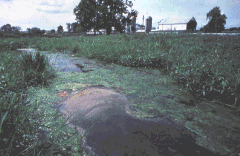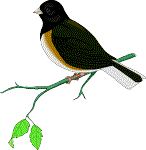 |
Major
pollutants in the chesapeake bay are
nutrients. The two primary nutrients are nitrogen and phosphorus.They are essential for
life and occur naturally in soil and water. |
| Sewage treatment plants,
industries, vehicle exhaust, acid rain, and runoff from agricultural, residential and
urban areas are the major sources of nutrients entering the Bay. Nutrients run off the
land in sediments and fertilizers and enter the bay from sewage treatment plants.Lots of
nitrogen and phosphorus can be found in fertilizers used on lawns farm fields, human
sewage. Majorly there are two types
of nutrient sources-- |
| 1.Point
Source and 2.Non-point source |
| Point source:Nutrients
coming from a specific source like sewage treatment plants and industrial wastes.
Non-point source:Pollutants coming from many diffuse
sources. This may be caused by rainfall or snow melt.Pollutants picked up are mainly human
wastes carried and deposited into the lakes, rivers and other water resources. |
Effects of nutrient pollution:
|
| Normally nitrogen and
phosphorus are essential for life in bay in normal quantities. Only in excess that they
cause problems. Excessive nutrients trigger algal blooms in the bay.(Algae are single
celled plants present in all water systems.)This excessive growth of algae blocks the sun
light from reaching the SAV beds and thereby destroying them. |
|
After these excessive algae die, they are decomposed by bacteria which uses large
amounts of oxygen.Low oxygen levels effects all the living organisms in the bay. |
|
This is called "Eutrophication" which is the result of deadzones that are
virtually devoid of life, because most of the living beings cannot survive without oxygen. |
 |
|
A few statistical facts about nutrients reaching
the bay:
|
| In the past when the bay
was surrounded by large areas of forests and wetlands, relatively little or none amounts
of nutrients enter the bay.But with the rapid population growth ,reduction in forest areas
and increase in industries the amount of nutrients entering the bay has increased
tremendously. 318 million pounds of nitrogen and more than 19 million pounds of phosphorus
reach the Chesapeake Bay each year. |
|
|
How can we be a part of the solution?
|
- Reduce the nutrient input to the bay:
Reduce the use of fertilizers in lawns and
fields.Plant native vegetation that requires less water and less fertilizers.
- Reduce erosion by planting trees along the
shoreline.
- Reduce the wastage of water.
- Try to use natural fertilizers and reduce the use
of toxic cleaning materials around the house hold.
- Trying to be a part of a voluntary organization.
|
What is being done?
|
|
The Chesapeake Bay Program has been working in cooperation
with local governments, industry, farmers, environmentalists, conservation
associations, citizen groups and others throughout the Bay region to restore the
water quality in the Bay and its rivers by reducing pollution, since 1983.
In the 1987 Chesapeake Bay Agreement, the Executive Council of the Chesapeake
Bay Program set a goal to reduce the nutrients nitrogen and phosphorous entering the
Bay by 40% by the year 2000. Achieving a 40% nutrient reduction will ultimately
improve the oxygen levels in Bay waters and encourage aquatic life to flourish.
The reduction targets for each tributary use nutrient loads from 1985--the baseline
for the 1987 Agreement.Nutrient management plans provide nutrient recommendations based
on realistic expected crop
yield, existing nutrient levels in the soil, appropriate timing and placement of
nutrients and other normal farming practices related to efficient nutrient utilization, with particular emphasis on
environmentally sensitive areas. |
| Return to the Top |


